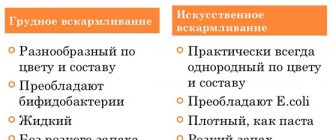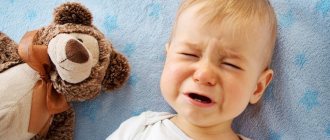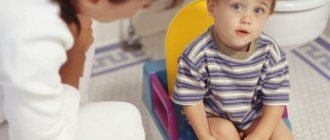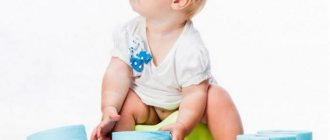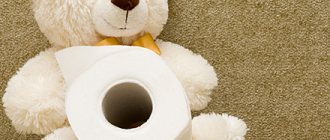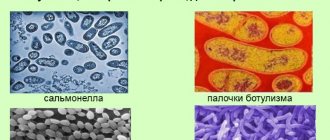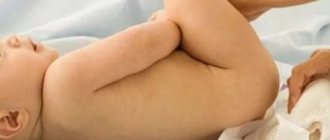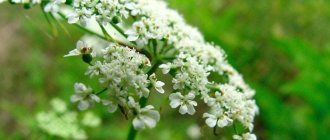Foamy stool in a child in the first days and months of life frightens young parents, but given the physiological characteristics of the infant’s body, there is no need to panic. To eliminate the danger, you should immediately visit a pediatrician and deal with the problem if it exists. Additional consultation, determination of what is considered normal and pathology should lead to a stable psycho-emotional state for the mother. Children are sensitive to the experiences of loved ones and a woman’s peace is above all else.
Description of the disease
It is worth noting that in itself, babies’ stool is often unformed, and this is the norm. Liquid food does not form dense clusters. If the stool becomes compacted, we are talking about the beginning of the development of constipation. The act of defecation should not cause pain or discomfort.
Diagnosis of diarrhea is complicated by the fact that from the birth of the baby, feces undergo some changes. In the first days, meconium is released in the form of a black-green putty, oily and difficult to wash off from the skin. Subsequently, due to the predominantly breast milk in the diet, the discharge turns into liquid, white lumps, heterogeneous stool.
The smell of feces during natural feeding is sour, but in artificially fed children it is unpleasant. The feces foam in a child during the period of organizing the work of the digestive organs and this is not considered a deviation if there are no additional symptoms.
It is quite natural if the color of the stool is brown, yellow, and even green foamy stool in a child; this is not always a sign of a serious pathology. Starting from the first days of life, enzymes are formed and for some newborns this process is painful.
If the discharge is splashy, foul-smelling, green and excessively liquid, the child becomes restless and cries, so you should be wary and pay attention to additional signs of illness. Any doubts are a reason to consult a doctor without delay.
How to treat?
What to do if your baby poops foam? This question is very relevant for many young parents. The need to treat this manifestation depends on what it is associated with.
In infants, foaming usually goes away without medications as the child grows older. Breastfed babies with foamy stools do not require special treatment. Depending on the cause, the doctor may make adjustments to the daily diet of a nursing mother.
At an older age, when the child begins to attend kindergarten (2-4 years) and the risk of infection increases, the little patient may be prescribed drug therapy. In the case of fermentative dyspepsia, the child will have to be put on a strict diet without the need for drug treatment.
Medication approach
The specialized specialist should also clarify the method of its use and inform the parents of the young patient about possible side effects. Drug therapy is necessary for patients in the following cases:
- For dysbacteriosis. If the cause of foam in the stool is dysbiosis, the baby cannot do without prebiotics and probiotics. The most effective and safe medications for children include Bifiform Baby, Bifidumbacterin (we recommend reading: how should Bifidumbacterin be given to newborns?).
- For food allergies. If a child's foamy stool is a reaction of the intestines to a particular food product, parents should consult an allergist. In this case, the doctor prescribes sorbents, as well as antihistamines.
- When infected with rotavirus, staphylococcal or intestinal infection. Treatment should include the intake of sorbents and regulators of water-salt balance (electrolytes).
Mom's diet if the baby is breastfed
Changes in the consistency and color of stool in breastfed children directly depend on what the mother eats. If she overuses sweets, smoked and spicy foods, the likelihood that the child’s stool will be foamy is very high. Key recommendations for nursing mothers include:
- Exclusion of products that lead to increased gas formation (legumes, soda, grapes, cucumbers). Cow's milk can be consumed by a nursing mother in minimal doses.
- Correct choice of heat treatment. The best option is stewed or boiled food; the consumption of fried foods should be limited as much as possible.
- Eating only healthy foods. Fruits, vegetables, herbs, lean meat, fish, soups and cereals are essential elements of a healthy diet for a nursing mother.
Causes
Diarrhea with foam in a child or diarrhea is a dangerous, common pathology that can quickly provoke dehydration and asthenia. There are many causes of the disease, and in order to prescribe adequate therapy, it is important to find out what negative factor led to the disease and eliminate it.
In children, regardless of age, loose stools with foam and stench sometimes appear, and the causes of the phenomenon are different:
- Hypolactasia is a pathology in which a deficiency of the enzyme that facilitates the digestion of lactose is diagnosed. Inability to digest milk sugar can occur from birth or develop against the background of some disease.
- Caelicalia is a gluten energy disorder. This phenomenon is caused by the body’s immunity to protein - gluten, of plant origin. The pathology is usually diagnosed before the age of 2, after which wheat, barley, rye, and oats should be excluded from the diet on an ongoing basis. There are several clinical forms:
- rickets-like;
- anemic;
- hemorrhagic;
- septic;
- edematous;
- erased.
- Dysbiosis is an imbalance of microflora in the intestine, with the predominant majority of pathogenic microflora. When a baby is born, the intestines are free of bacteria. Settlement begins with the consumption of breast milk. Subsequently, thanks to the correct concentration of microorganisms, digestive function is improved. At a later age, during antibiotic therapy, dysbacteriosis can also occur.
- Intestinal infections:
- rotavirus;
acute intestinal;
- Escherichiosis.
- Allergic reactions. Abnormal stool is the body’s response to the action of an allergen. Usually, diarrhea is accompanied by a rash in different areas, itching, and tissue swelling.
- Poor nutrition does not affect the child’s appetite and development, but causes severe discomfort. The same symptoms accompany a baby when overfed.
The group of diseases proceeds quite aggressively, with pronounced symptoms from the gastrointestinal tract. Infants and slightly older children are most prone to pathology.
The first symptoms cannot be ignored, as dehydration occurs quickly and in a short time.
For infants, the symptoms are dangerous, as they contribute to the development of rapid dehydration. Diarrhea with foam and stench requires a quick response from parents and doctors.
Causes of foamy stools in children
In a small child, the intestines are sensitive to various food additives and new products. For this reason, foamy diarrhea in a baby can occur quite often.
This is normal in newborns. It is difficult to talk about diarrhea at this age, since the stool is basically liquid, and the frequency of bowel movements up to 7 times a day is considered normal. If your child does not have any other alarming symptoms, there is no need to worry. The presence of foam in the stool indicates accumulated gases. If the color of the stool or consistency has not changed, the baby does not have abdominal pain, he does not lose weight, there is no reason to worry.
If the consistency of the stool has become more liquid, the color or smell has changed, we can talk about diarrhea. The following factors can provoke foamy diarrhea:
- Lactose intolerance. With lactase deficiency, milk is poorly digested, colic, flatulence, foam in the stool and diarrhea begin. This phenomenon usually occurs in children under one year of age. Special low-latose mixtures and cereals will help solve the problem.
- Poor nutrition. Children get used to the diet gradually. The intestines can react violently to certain foods. It is necessary to eat in moderation; an abundance of food can also cause disruption of the digestive system.
- Late introduction of new products. Foam in the stool occurs after the introduction of a new dish in the diet that is not suitable for age. Food introduced too early after an intestinal infection can also trigger diarrhea.
- Infection. Such diseases are accompanied not only by stool disturbances, but also by other symptoms, for example, increased body temperature. The disease can be caused by bacteria, viruses, fungi, and worms.
- Dysbacteriosis. In the womb, the baby's intestines do not work at full capacity. It begins to be populated with beneficial bacteria after birth. During this period, children are prone to dysbiosis if the number of harmful bacteria exceeds the permissible level. In most cases, the body copes with the problem on its own.
In an infant, foamy stools may be caused by a lack of breast milk. In this case, it is necessary to restore lactation and adhere to a special diet for nursing mothers.
Only a doctor can make a diagnosis. You should not diagnose or self-medicate at home.
Symptoms
The clinical picture is such that it is difficult to confuse it with liquid feces caused by physiological reasons. It is enough for the mother to take a closer look at the baby to notice foamy stools and other symptoms in a month-old baby or older children:
- foamy diarrhea;
- bloating;
- rumbling;
- excessive regurgitation;
- moodiness;
- complaints of abdominal pain;
- rumbling;
- colic;
- lack of appetite;
- nausea and vomiting;
- liver dysfunction;
- nosebleeds;
- intoxication;
- hyperthermia;
- foul odor of feces;
- circles under the eyes;
- weight loss;
- impurities of mucus and blood inclusions in the stool.
A child with such symptoms does not show interest in toys, is lethargic, capricious, and apathetic. A newborn has loose, foamy stools that can cause dehydration and be fatal. If the feces are liquid and the color of the child’s stool has changed to white foamy, the mother should conduct a detailed analysis of the food consumed in her diet (if breastfeeding) and the baby – if he is artificial.
Also, the cause of whitish stools is dysbiosis, pathology of the liver, pancreas. The color of stool is an important diagnostic sign. If yellow diarrhea with foam in a child is not the cause of dysbiosis, then most likely it is a sign of non-compliance with the diet. When drinking only foremilk (which the baby eats at the very beginning of feeding), the baby's stool becomes yellow and foamy. Even before giving birth, a woman should learn how to breastfeed correctly in order to maintain the lactation period longer and give the baby everything she needs.
Causes of foamy discharge in children
The concept of stool norms for newborns is quite conditional.
Pediatricians say that stool should look like in the photo - have a yellow-brown color and a porridge-like consistency. The stool of bottle-fed babies has more stable characteristics. The color and consistency of the stool of breastfed children depends not only on what the baby eats, but also on the nutrition of his mother. Accordingly, the mother must be very selective in her taste preferences. Due to the fact that in infants the enzyme system is at the stage of formation, there may be white lumps in the baby’s stool, and its liquid consistency does not necessarily indicate the development of the disease. Parents should monitor their baby's stool very closely if mucus or blood is found in it. Diarrhea with foam should also be an alarming signal for the mother. In this case, parents need to immediately go with the baby to the hospital to diagnose the pathology.
Allergy to food enzymes
Food allergies are one of the most common causes of foamy stools in babies. The enzyme system of a small patient is at the stage of formation, which is why infants are most often susceptible to allergies to food enzymes. The main provoking factors include:
- Poor nutrition. Early complementary feeding is the first factor that provokes foaming in the stool of an infant. Some mothers begin giving the first porridge and soup at 4 months. According to the recommendations of pediatricians, complementary foods can be introduced no earlier than 5 months. The most optimal age is 6-7 months. As for cow's milk, it is better to start giving it after the child reaches one year of age.
- Non-compliance with diet by a nursing mother. Abuse of prohibited foods (smoked meats, sweets) can lead to upset bowel movements in the baby.
Lactase deficiency
Breastfed children often face the problem of lactase deficiency, which leads to malnutrition, poor weight gain, and gastrointestinal disorders. Lactose deficiency is due to the fact that the baby does not have enough hindmilk. The translucent foremilk is enriched with proteins and minerals. As for fats, they are found in hind milk.
In order to prevent the development of lactase deficiency in the baby, a nursing mother should under no circumstances take away the breast from the baby until he refuses it. Many mothers change breasts too quickly, as a result of which the baby simply does not receive hindmilk enriched with fats. Pediatricians insist that the optimal feeding time on one breast is 20 minutes.
Intestinal dysbiosis
Intestinal dysbiosis is a disease that causes a lot of controversy among modern doctors. A child is born with a completely sterile intestinal tract, in which a healthy microflora should form within a few months. A lack of beneficial bifidobacteria or an excessive amount of pathogens can lead to the fermentation process. Its manifestations are gas, rumbling, green diarrhea with a putrid odor, which alternates with constipation.
Treatment of diarrhea in a child
To prescribe the correct treatment regimen, the child must be examined by a doctor. After collecting anamnesis, studying all dietary habits and habits, the pediatrician prescribes a laboratory test of stool for the presence of hidden blood inclusions and opportunistic microflora. For a more accurate diagnosis, the following is prescribed:
- malabsorption tests;
- serological studies;
- sweat test;
- provocative tests to identify the allergen.
The diagnosis of dysbacteriosis is made by a doctor. Therapy includes treatment with drugs containing lacto and bifidobacteria to normalize the microflora.
Drug treatment
In addition to saturating the body with beneficial microflora, signs of intoxication should be eliminated and harmful bacteria should be eliminated.
Mobile bacteria Campylobacter, the causative agent of infection
For this purpose, adhere to the following algorithm of actions:
- saline solutions (“Regidron”, “Glucosan”, “Oralit”, “Gastrolit”);
- glucose solution diluted in water - for drinking;
- preparations with paracetamol to reduce high fever (suppositories, syrups);
- sorbents (“Smecta”, “Microsorb-P”, “Activated carbon”, “Filtrum”, “Enterodez”);
- symptomatic drugs for diarrhea (“Diarol”, “Bismuth”);
- intestinal antiseptics (“Kanamycin”, “Gentamicin”, “Polimexin”, “Furazolidone”);
- enzymes (“Mezim forte”, “Pancreatin”, “Pangrol”);
- probiotics (“Bifidum baby”, “Bifidumbacterin”, “Enterol”, “Hilak forte”);
- antibacterial drugs;
- antihistamines;
- antispasmodics (“Papaverine”);
- antibiotics (“Furazolidone”, “Nevigramon”) - if the doctor considers it appropriate.
During illness, it is necessary to more carefully monitor the replenishment of the water balance. Also, in order to eliminate the burden on the inflamed digestive system and liver, the baby is provided with dietary nutrition.
Dietary recommendations
- smoked, salted, fatty, fried foods - exclude completely;
- prepare pureed soups, rice water, porridge with water;
- Stewed vegetables and fruits from compotes are allowed;
- you should often offer water, decoctions, compote;
- in the first days of illness, it is recommended not to offer fermented milk products;
- After the diarrhea can be stopped and the condition stabilized, the child can be offered crackers and sweet tea.
Traditional treatment
Alternative medicine has proven itself well and can indeed be an auxiliary method of combating loose, foamy stools in a child, but when symptoms appear in infants, you should not waste time on herbal treatment.
Typically, medications have a cumulative effect. In order not to bring the body to dehydration, you should entrust your fate to doctors of conservative medicine, and only after the danger is left behind, to restore the mucous membranes of the digestive system, can the following be used:
- Rose hip.
- Chamomile.
- Yarrow.
- St. John's wort.
Herbal remedies are not as safe as they may seem, therefore, additional traditional methods should be discussed with your doctor. Mothers should closely monitor changes in the baby's condition. If a child has foam instead of feces, then this is not the best moment for experiments, since the symptom indicates a rapid loss of water by the body and the aggressive actions of an intestinal infection. Even if a child has diarrhea with foam, without fever, you should not self-medicate.
Diagnosis and drug treatment
If a child develops foamy diarrhea, an examination is required. It may include a blood test, stool test for worms, urine culture, ultrasound, x-ray, etc. Diagnostic methods are determined after collecting an anamnesis. It is necessary to indicate how long the diarrhea lasts, after what it occurred, what symptoms are accompanied, and whether there are chronic diseases.
If your child has foamy, light-colored diarrhea, you will need to donate blood for liver function tests. Light-colored feces often indicate a liver problem. It produces insufficient bile, which, when mixed with digestive enzymes, gives the stool a yellow or brown color. White stools can be a sign of viral hepatitis and other serious diseases.
Drugs are prescribed to a small child with caution. For diarrhea with the appearance of foam, the pediatrician may prescribe the following medications:
- Probiotics. Probiotics populate the intestines with beneficial bacteria that normalize microflora. They are useful for dysbiosis. Popular drugs include Acipol, Linex, Bifidumbacterin.
- Lactase substitute. If your own enzyme is not enough and milk is poorly digested, there is no need to give up breastfeeding and switch to formula. Drugs are sold that help digest lactose, for example, Lactazar and Lactase Baby. They are added to milk before giving to the baby.
- Antibiotics. They are prescribed only in extreme cases when a bacterial infection is present and needs to be eliminated. At the same time, it is recommended to take probiotics, since antibacterial drugs can provoke drug-induced dysbiosis.
- Enterosorbents. They absorb toxins and remove them. Sorbents are necessary for poisoning. The most popular are activated carbon, Enterosgel, Polysorb. It is worth considering that they may reduce the effectiveness of other drugs when taken simultaneously.
Prevention
Foamy stool in a child is a serious symptom that should not be ignored. If the cause is not related to overeating, then it can be so serious that hospitalization cannot be avoided. It is worth noting that by following some mandatory rules, diarrhea with foam and foul odor can be avoided. This is why you should:
- Observe the rules of personal hygiene and teach your child to them from an early age.
- Products such as eggs, milk, fish must be processed thermally.
- It is recommended that children cook food only using gentle methods (oven, steamer, multicooker).
- All vegetables, fruits, and citrus fruits should be washed before eating.
- You should not drink raw tap water; you should stock up on bottled water and use a filter.
- Monitor the expiration dates of the food you buy and do not buy fermented milk products with expiration dates on the packaging.
- After contact with animals, walking outside, before eating, you must remember to wash your hands.
- The well-being of breastfed children depends on the hygiene and diet of the mother.
- Loose stools with foam in a baby can be caused by the mother's erratic diet - pediatricians recommend adhering to a special diet.
- The approach to introducing complementary foods should be conscious and competent.
- For artificial feeding, it is worth choosing mixtures with probiotics and vitamin complexes.
- The habit of licking the baby's pacifier and spoon by adult family members should be eradicated.
- It is necessary to pay attention to the formation of barrier functions of the body.
- Create a favorable psycho-emotional environment, as stress weakens the immune system.
- Avoid polluted beaches and public bathing areas.
By following basic rules, you can significantly reduce the risk of foamy diarrhea in a child with a foul odor.
Prevention is not a guarantee, since diarrhea of infectious origin can occur through contact with sick children. Most often, foamy stool occurs in a child at the age of 2, when he learns about the world in more detail, attends kindergarten, and plays in common sandboxes.
Treatment with folk remedies and prevention
Traditional medicine recipes are very popular among mothers. They act more gently on the body and have fewer side effects. But taking herbs and decoctions should be taken seriously. They can cause a severe allergic reaction, especially in infants. You should consult your doctor before taking herbs and honey.
Popular and safe folk remedies for treating diarrhea in children are:
- Chamomile and mint. Decoctions of these herbs can be added to tea and given little by little to the child. They relieve inflammation well, soothe the mucous membranes of the stomach and intestines, and stop diarrhea. The decoction in its pure form is drunk in small sips throughout the day.
- Honey. This useful product helps with many diseases. It has anti-inflammatory properties and restores intestinal microflora. However, honey is a strong allergen and should be given to children under 3 years of age with caution.
- Rice. A safe and effective remedy for diarrhea is the decoction that remains after cooking rice. Rice should be rinsed well with clean water after cooking. The drink is given to the child in small portions throughout the day.
- Tea. With diarrhea, a large amount of fluid is lost, so you need to drink a lot. In addition to clean water, black tea is useful, as it strengthens and stops diarrhea.
- Bird cherry. In bird cherry, both fruits and bark have a fixing effect. They need to be poured with boiling water and left to steep. The cooled broth is taken half a glass 2 times a day.
- Apples. Fresh fruits can increase gas formation and irritate the stomach and intestines. Therefore, it is recommended to give baked fruits to children. For babies, you can grind them in a blender. You should not add nuts or cottage cheese.
You can feed your child if he has diarrhea if he still has an appetite, but you should not force him to eat. Nutrition should be balanced and dietary.
Prevention of intestinal disorders is hand and chest hygiene during breastfeeding, proper nutrition. Products should be introduced into the child’s diet gradually and in a timely manner. It is worth limiting the amount of sweets and fatty foods. While breastfeeding, a nursing mother needs to monitor her diet.
